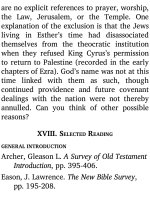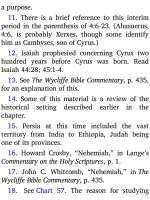Jensens survey of the old testament adam 510
Bạn đang xem bản rút gọn của tài liệu. Xem và tải ngay bản đầy đủ của tài liệu tại đây (116.72 KB, 4 trang )
your Bible, and then on paper record a title
for each paragraph: 1:1, 3, 9, 13, 21, 24;
2:1, 4, 8, 16, 20; 3:1, 5, 12, 18; 4:2, 7, 10,
15, 18.
Record any new impressions and
observations of the letter.
C. STRUCTURE OF THE BOOK
Read through the epistle a few more
times, looking for:
1.
organization
of
content
(e.g.,
introduction, main body, conclusion)
2. kinds of content (e.g., doctrine,
practice)
3. any pivot, or climax
4. a prominent theme.
D. SURVEY CHART
Chart 88 is a survey chart of Colossians.
After you have looked it over at least in a
general way, follow the study suggestions
given.
1. Note on the chart the opening and
closing benedictions. Also note the two
sections identi ed as mainly personal. Read
the Bible passages involved, to justify these
descriptions. The section called mainly
doctrinal begins at 1:13 because a major
concentration on the subject of Christ is
introduced here (“His beloved Son”), to be
developed in the verses that follow.
In the survey studies suggested below you
will want to nd out why major divisions on
Chart 88 are also made at 2:4; 3:5; and 4:7.
Justify the other observations made below,
always by referring to the Bible text.
2. Note the three parts of the main body
of the epistle. Polemical means that which
refutes errors of doctrine. Hortatory as used
here includes both exhortation and
command.
3. Read 2:4 and observe how in this verse
Paul begins to write about false teachers
who were threatening the Christians at
Colossae. Read also the opening phrases of
2:8, 16, 18. What errors or false teachings
do you see referred to in the section 2:4—
3:4?
4. Note on the chart that the hortatory
section begins at 3:5. Read paragraph 3:1-4.
You will observe that this paragraph is also
of a hortatory nature. But it is included in
the previous section (polemical, 2:4—3:4)
because it is closely related to paragraph
2:20-23. (For example, compare the rst
phrases of 2:20 and 3:1.)
5. The concluding personal section begins
at 4:7, because here Paul begins to bring in
personal notes and salutations.
6. Colossians is basically of three kinds of
writings: doctrinal, practical, and personal.
Note the outline at the top of the chart
showing this.
7. Study the other outlines that represent
the content of the major divisions of
Colossians.
IV. PROMINENT SUBJECTS
A. THANKSGIVING AND INTERCESSION
(1:3-12)
The letter begins on a bright, cheerful
note, typical of Paul’s writings. There is no
clue here that a heavy burden concerning
problems at Colossae lay on the apostle’s









